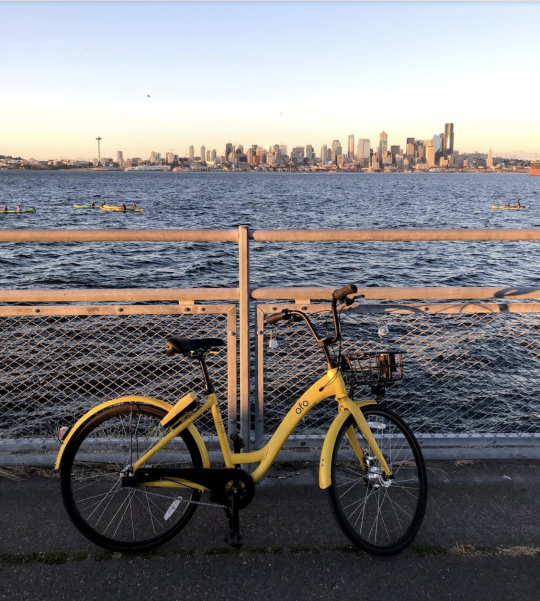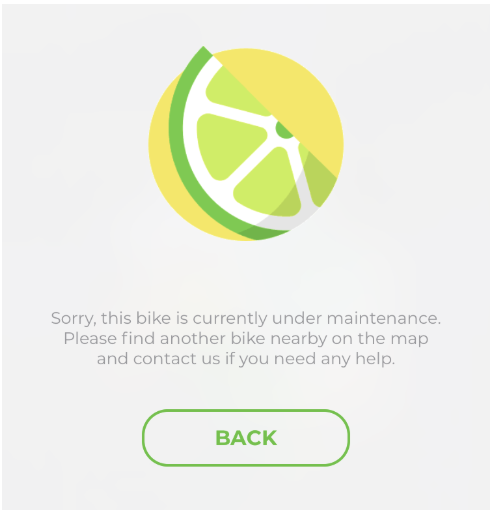User Experience and Measurement Lessons From Bike Sharing at the Beach
Let’s pretend for a second that the bike and scooter sharing startups have sound business models. They’ll break even on the bikes/software/maintenance, and make money selling the route data to mapping and advertising companies or something. Have you suspended your disbelief? Great. Now picture the perfect setup for customer acquisition for these startups…
It might look something like this:

A sunny day at Alki Beach in Seattle. A jogging & biking path that goes on for 4 miles of beautiful views and people-watching. A place where it’s really hard to find parking, there are tons of people outside, and they can’t walk all the way back to their cars in flip flops. Where couples and families come specifically to move around in the sun, to see all the views, and to make it all the way from one end to the other and back.
People at Alki have the need for temporary bikes. Pedestrians see folks riding colorful mobile-app-rented bikes all around them. It’s like free advertising to a perfect target market.
This is the situation I found myself in a few weekends ago. On a beautiful sunset walk with my wife. Enjoying the views with tired legs and a hungry belly. Bikers, skateboarders, and foursomes on rented rickshaws zooming by us. We saw a number of people using bright green Limebikes, yellow Ofo bikes, and orange Spin bikes. We parked our car and walked two miles West to a pirate-infested beach bar with bacon pizza and Adirondack chairs (no joke about the pirates). On the way back, we wanted to pedal. I’d used Limebike twice before, so I knew what to expect: a heavy, poorly-fitting bike that we could ride for a few miles for a dollar. My wife was a bikeshare n00b.
Bike Sharing #ProductFail x3 Companies
So what was the #ProductFail? Where are the lessons? Basically everything about the user experience starting at the point where I decided I wanted us to bike back to our car.
There was a Limebike right outside our pirate beach bar. “Perfect!” I thought, and started fiddling with my phone to unlock it.
Problem #1: “This bike no worky.”

No dice. “OK - well let’s walk a little farther away from the car to get a bike - I think I see another Limebike way down there.”
Problem #2: Two would-be bikers interested at the same time.
Just as we made it to the bike at the end of the line, another guy was walking toward it with his friend. We talked about it awkwardly for a minute and he decided to let me have the bike. OK, time to try unlocking it.
Problem #3: Out of battery

Two bad bikes in a row, ouch.
“Wait, can’t we pedal an electric bike that’s out of battery? No. I can’t believe this. OK, let’s start walking back the way we came from and keep our eyes peeled, there are lots of bikes around.”
After 5 minutes of walking back the way we’d come from… “Here’s a Yellow one. I guess I can download another app and enter my credit card info - they all work the same way, one brand’s as good as another, right?”
Wait for the download over cellular. Open the app and create an account. Fiddle with my credit card out on the sidewalk - you can’t get your first free ride without a credit card entered…
Problem #4: This yellow bike no worky either :-(

At this point I was wondering if I just had unbelievably bad luck, or if all of these bikes are running on such a rickety operational model and software platform, that they’re basically unsuited for busy outdoor areas.
It also occurs to me that when there’s high rideshare bike demand, there’s a much higher chance that any idle bikes which appear to be available are actually the ones no one can get to work.
…more walking with the wife… she’s resigned to walk back, but my feet hurt and I’m more determined than ever to get a working bike to ride.
Problem #5: Third green bike no worky.

“OMG - this is a laughably bad experience. I’m gonna blog about it.”
…more walking…
Problem #6: Vandalism.

“We don’t want a third app do we?”
“Don’t bother, it has no seat. (orange)
…more walking…
Problem #7: I use my app to unlock a bike, but someone standing nearby says it’s his.
We see a bunch of parked yellow bikes and I’m thinking “finally, these must work!”
I unlock the first one. But then a kid looking at the view with his family says “that’s my bike, wasn’t it already unlocked?” But my app has the bike checked out to me… “Oh, sorry, but my app is counting time now.” There are four yellow bikes here and three of you, is that OK? He agrees, and I get a sweet, sweet, ride on a heavy, poorly-fitting bike.
Problem #8: A second Ofo bike is “closed for maintenance.”
The only problem is the other yellow bike that my wife tries (after downloading the same new app to her own phone, creating an account and entering a credit card) also doesn’t work and shows an error message.
So we pretend we’re 10 again and we actually try riding two people to a bike. I thought it was hilarious. But, my wife can’t keep from sliding off the seat and this is a bit nuts - we don’t really want to explain a bike crash with both of us on one bike with no helmets to our kids. We decide to walk back.
===
Building a Better Bike Sharing Product
OK - so we can all agree that was a horrible customer experience. How could the bike share companies build better products?
Let’s follow a straightforward approach that starts with understanding users and the problems they run into, prioritizes a good user experience, and tracks success in the metrics.
Understanding users and their bike share problems:
User feedback will come in through many mechanisms, including app store reviews and twitter… but to tangibly improve our user understanding, we want to survey some small percentage of our users. When? All the important times: right after they’ve finished a bike ride, right after they’ve encountered a problem, and when they’ve used the app an unusually long amount of time (this indicates a problem or an uncommon use case). And we should couple this quantitative survey work with qualitative work (e.g. tag-alongs or diary studies involving frequent bike share users, and in-person street intercepts of new users in busy bike-sharing areas like Alki Beach).
Prioritize a good user experience and track success:
In addition to our “understand work” above, we want to log all the bad experiences we can catch (such as bike inoperable error messages), and set goals to drive down the number of users having bad experiences per day/week/month. With a goal set to minimize bad experiences, it will be easy to prioritize fixes to problems, and we can rank those problems based on how often they are experienced X the severity of the effect on user sentiment (e.g. Net Promoter Score).
Some ways to fix the problems I encountered:
Bike inoperable product fixes:
In all the cases that I hit bike inoperable error messages above, I was clearly, obviously “having a bad time.” This is the equivalent of a crash or hang with most software. I was all ready to ride a bike and pay for my ride, but I could not.
The product teams could make major improvements by doing the following:
- Log all these errors by type
- Goal on reducing them both in terms of raw counts and in terms of total people affected
- Do follow up field research in areas where error rates are abnormally high
- Goal the maintenance teams on reducing the length of time bikes are inoperable and out in the field generating bad user experiences
- Help users avoid these situations in the first place by much more obviously directing them to the closest working bikes, and warning them boldly in app (both visually and audibly) about any very nearby bikes that are offline for maintenance or out of battery.
- Help users who hit a bike inoperable case find a working ride as quickly as possible, and both apologize and compensate them for the bad experience to turn a negative situation into a positive if possible.
Vandalism product fixes:
A bike with a missing seat, missing front wheel, or missing chain is just another form of inoperable bike.
The product team could invest in:
- Detecting missing bike components via bluetooth or RFID sensors
- Treating any bike with a missing component just like an inoperable bike (with the techniques above)
Social product fixes:
People will occasionally walk around and want the same bike at the same time. But we can both minimize these cases, and help folks navigate these cases via the product.
The product team could:
- Attempt to steer nearby users with the app open to different nearby bikes
- Institute rules about scanning bikes that are still on someone else’s clock - buzzing both phones and asking the current bike holder if they’re willing to release the bike to someone new or not.
- Put a “two people want this bike” button front and center on the apps map view. Hitting this button could suggest the next closest bike, offer some suggestions for communication and decision-making, and have an option to randomly select a “winner” in the case that neither person is willing to defer. Underneath the random assignment function, the team could prioritize any person who just came off a bad experience such as losing a random assignment or finding an inoperable bike recently.
Wrap-up:
Many products are a combination of physical goods, software, and operations. Many products are used in complex social environments that can complicate usage. Some products are local, and may perform well in terms of metrics at the top level (like across a city or a country), while still harboring very broken user experiences in lower-level locations and for a minority of users. But any product with these attributes will hit a growth ceiling, as the bad experiences result in churn and negative word-of-mouth that creates a drag on the overall product.
Today we looked at three high-flying bike sharing companies with plenty of VC money, that are likely in this zone right now: showing positive growth and usage numbers, but perhaps also struggling with declining growth and metrics ceilings. Thinking about your best case and worst case scenarios… doing a deeper level of understand work, and then prioritizing and thoroughly solving your top user problems can unstick your product and unlock a new round of growth.
Have a story like this? A horrible user experience or a product with strong top-level metrics that’s slowing down or burdened by some bad user experiences? Ping me on LinkedIn or Facebook Messenger - I’d love to hear about it.
–
